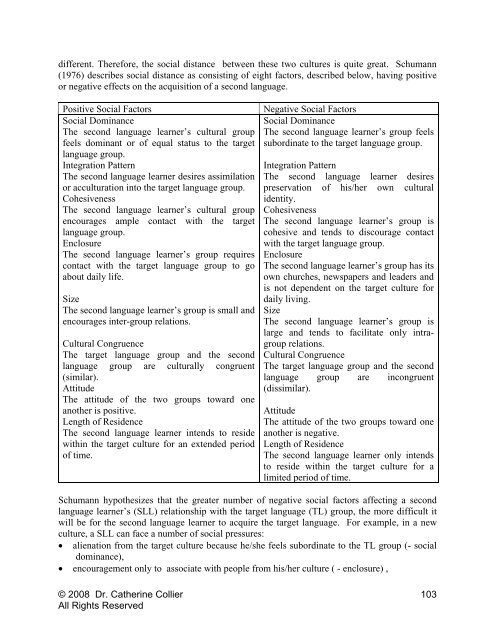Art Un ticle I.1 ited Sta In the ates News - Woodring College of ...
Art Un ticle I.1 ited Sta In the ates News - Woodring College of ...
Art Un ticle I.1 ited Sta In the ates News - Woodring College of ...
- No tags were found...
You also want an ePaper? Increase the reach of your titles
YUMPU automatically turns print PDFs into web optimized ePapers that Google loves.
different. Therefore, <strong>the</strong> social distance between <strong>the</strong>se two cultures is quite great. Schumann(1976) describes social distance as consisting <strong>of</strong> eight factors, described below, having positiveor negative effects on <strong>the</strong> acquisition <strong>of</strong> a second language.Positive Social FactorsSocial DominanceThe second language learner’s cultural groupfeels dominant or <strong>of</strong> equal status to <strong>the</strong> targetlanguage group.<strong>In</strong>tegration PatternThe second language learner desires assimilationor acculturation into <strong>the</strong> target language group.CohesivenessThe second language learner’s cultural groupencourages ample contact with <strong>the</strong> targetlanguage group.EnclosureThe second language learner’s group requirescontact with <strong>the</strong> target language group to goabout daily life.SizeThe second language learner’s group is small andencourages inter-group relations.Cultural CongruenceThe target language group and <strong>the</strong> secondlanguage group are culturally congruent(similar).AttitudeThe attitude <strong>of</strong> <strong>the</strong> two groups toward oneano<strong>the</strong>r is positive.Length <strong>of</strong> ResidenceThe second language learner intends to residewithin <strong>the</strong> target culture for an extended period<strong>of</strong> time.Negative Social FactorsSocial DominanceThe second language learner’s group feelssubordinate to <strong>the</strong> target language group.<strong>In</strong>tegration PatternThe second language learner desirespreservation <strong>of</strong> his/her own culturalidentity.CohesivenessThe second language learner’s group iscohesive and tends to discourage contactwith <strong>the</strong> target language group.EnclosureThe second language learner’s group has itsown churches, newspapers and leaders andis not dependent on <strong>the</strong> target culture fordaily living.SizeThe second language learner’s group islarge and tends to facilitate only intragrouprelations.Cultural CongruenceThe target language group and <strong>the</strong> secondlanguage group are incongruent(dissimilar).AttitudeThe attitude <strong>of</strong> <strong>the</strong> two groups toward oneano<strong>the</strong>r is negative.Length <strong>of</strong> ResidenceThe second language learner only intendsto reside within <strong>the</strong> target culture for alim<strong>ited</strong> period <strong>of</strong> time.Schumann hypo<strong>the</strong>sizes that <strong>the</strong> greater number <strong>of</strong> negative social factors affecting a secondlanguage learner’s (SLL) relationship with <strong>the</strong> target language (TL) group, <strong>the</strong> more difficult itwill be for <strong>the</strong> second language learner to acquire <strong>the</strong> target language. For example, in a newculture, a SLL can face a number <strong>of</strong> social pressures:• alienation from <strong>the</strong> target culture because he/she feels subordinate to <strong>the</strong> TL group (- socialdominance),• encouragement only to associate with people from his/her culture ( - enclosure) ,© 2008 Dr. Ca<strong>the</strong>rine CollierAll Rights Reserved103
















